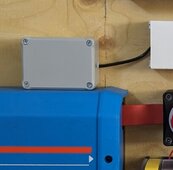Been working on this system for about a year now (including planning), I figured I might as well show you what I've got and what's in store for the future!
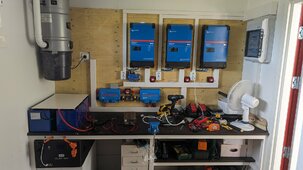
Specifications:
- 3x Victron MultiPlus-II 48/3000 in three-phase configuration
- Victron Lynx busbars + Victron battery switch + Victron SmartShunt
- EEL battery box with EVE LF280K cells, Seplos V2 BMS
- Cerbo GX
- Critical loads panel with manual transfer switch for maintenance
My main motivations for building this setup are:
- exporting excess solar power during the day is becoming a losing proposal, battery storage greatly helps with this dilemma
- backup power in case everything goes to shit (you never know these days with Russia as a neighbor)
- reducing the amount of money spent on energy transfer (cheaper tariffs during the night)
More details about the interesting parts:
Busbars:
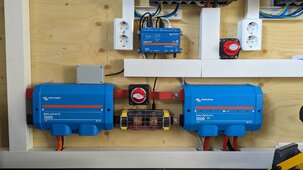
I bought some copper bars, then cut and bent them into the right shape in order to fit a main disconnect switch and a SmartShunt between the power in and the distributor. Some RV guy on some forum mentioned that the BlueSea mega-fuse busbar cover can hold the SmartShunt, turns out he was right and you can make it look pretty neat! Originally I used a cheaper DC breaker here, but during testing I noticed it get way to hot when pushing over 100A, so I had to shell out money for a Victron switch instead. Now it barely gets luke warm even at 160A which is the maximum load the inverters can put on the bus.
Grid meter:
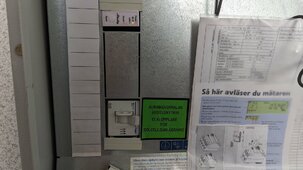
The Shelly Pro3EM is not officially supported as a grid meter by the Victron ecosystem, but I added support to it and it has been working flawlessly. Unfortunately, Victron seems reluctant to merge my changes. Here's the code for anyone who's interested: https://github.com/victronenergy/dbus-modbus-client/pull/4. I had the meter installed already since I've had somewhat of an obsession with metering all my consumption (even resorted to building my own software for aggregating data from multiple different meters, see https://github.com/Jalle19/eachwatt). The only electrical additions to this panel (the main panel) is the disconnect switch for the sub-panel inside the storage room where the inverters etc. are housed.
Backup circuits:
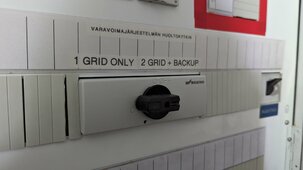
All wall outlets, the server room, heat pump (air-to-air), ventilation and lighting have been moved to a separate feed into the subpanel, via a transfer switch so I can switch them over to run directly from the grid in case I need to do maintenance on the inverters/batteries etc. The end result is that I have partial whole-house battery backup now.
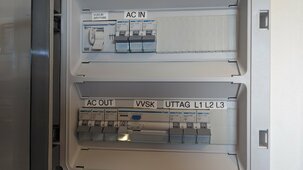
There's a separate sub-panel in the storage room, nothing special really. Power comes in, goes to the inverters then power from the inverters come back, feeding the sub-panel inside (the one where most loads are connected) as well as some supplementary wall outlets in the storage room.
Software:
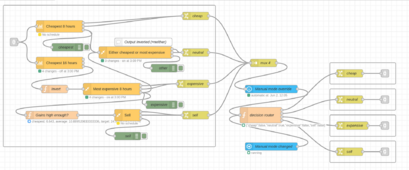
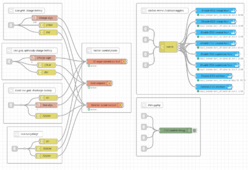
I use a combination of Node-RED and Home Assistant to decide when to charge the battery, keep it charged (i.e. grid pass-through), discharge the battery or sell/export from battery. The fact that I don't have any solar yet makes the algorithm a bit easier to grok, but the downside is that I can't really use any pre-existing algorithms (e.g. Victron's "dynamic ESS") since everything seems to revolve around self-consumption of solar energy.
Future:
Next summer I'll install 6.4 kWp of solar panels (two strings of 8 panels, east/west facing), a Victron MPPT RS 450/100 (you can see the empty spot on the wall that's reserved for it) and a second EEL battery box for a total of ~29 kWh of battery storage. Until then I'll try to optimize the power bill by leveraging the battery and selling when it makes sense. So far my average energy price since the system was installed a month ago has been around 1c/kWh, which isn't too bad. The higher the daily fluctuations, the higher the gains.
Various observations and things I've learned:
- don't cheap out on disconnect switches, the cheap ones can't actually handle much more than 50-100A
- don't underestimate the cost of the tiny things (battery cables, fire-proofed plywood, fuses etc.)
- the ESS assistant in Victron has completely bonkers defaults for lithium batteries which will result in you not being able to fully discharge your battery while on ESS (dynamic cut-off)
- Victron MultiPlus-II inverters are fairly noisy, especially the fan. I had to use rubber bushings and sound isolation to mount them to the wall to avoid vibrations reaching the other side (where the bedroom is). I've also had to limit charging power to 20A during 22.00-01.00 in order to reduce noise.
- always buy bigger cable ducts than you thought you needed
- always buy more battery storage than you thought you needed

Specifications:
- 3x Victron MultiPlus-II 48/3000 in three-phase configuration
- Victron Lynx busbars + Victron battery switch + Victron SmartShunt
- EEL battery box with EVE LF280K cells, Seplos V2 BMS
- Cerbo GX
- Critical loads panel with manual transfer switch for maintenance
My main motivations for building this setup are:
- exporting excess solar power during the day is becoming a losing proposal, battery storage greatly helps with this dilemma
- backup power in case everything goes to shit (you never know these days with Russia as a neighbor)
- reducing the amount of money spent on energy transfer (cheaper tariffs during the night)
More details about the interesting parts:
Busbars:

I bought some copper bars, then cut and bent them into the right shape in order to fit a main disconnect switch and a SmartShunt between the power in and the distributor. Some RV guy on some forum mentioned that the BlueSea mega-fuse busbar cover can hold the SmartShunt, turns out he was right and you can make it look pretty neat! Originally I used a cheaper DC breaker here, but during testing I noticed it get way to hot when pushing over 100A, so I had to shell out money for a Victron switch instead. Now it barely gets luke warm even at 160A which is the maximum load the inverters can put on the bus.
Grid meter:

The Shelly Pro3EM is not officially supported as a grid meter by the Victron ecosystem, but I added support to it and it has been working flawlessly. Unfortunately, Victron seems reluctant to merge my changes. Here's the code for anyone who's interested: https://github.com/victronenergy/dbus-modbus-client/pull/4. I had the meter installed already since I've had somewhat of an obsession with metering all my consumption (even resorted to building my own software for aggregating data from multiple different meters, see https://github.com/Jalle19/eachwatt). The only electrical additions to this panel (the main panel) is the disconnect switch for the sub-panel inside the storage room where the inverters etc. are housed.
Backup circuits:

All wall outlets, the server room, heat pump (air-to-air), ventilation and lighting have been moved to a separate feed into the subpanel, via a transfer switch so I can switch them over to run directly from the grid in case I need to do maintenance on the inverters/batteries etc. The end result is that I have partial whole-house battery backup now.

There's a separate sub-panel in the storage room, nothing special really. Power comes in, goes to the inverters then power from the inverters come back, feeding the sub-panel inside (the one where most loads are connected) as well as some supplementary wall outlets in the storage room.
Software:


I use a combination of Node-RED and Home Assistant to decide when to charge the battery, keep it charged (i.e. grid pass-through), discharge the battery or sell/export from battery. The fact that I don't have any solar yet makes the algorithm a bit easier to grok, but the downside is that I can't really use any pre-existing algorithms (e.g. Victron's "dynamic ESS") since everything seems to revolve around self-consumption of solar energy.
Future:
Next summer I'll install 6.4 kWp of solar panels (two strings of 8 panels, east/west facing), a Victron MPPT RS 450/100 (you can see the empty spot on the wall that's reserved for it) and a second EEL battery box for a total of ~29 kWh of battery storage. Until then I'll try to optimize the power bill by leveraging the battery and selling when it makes sense. So far my average energy price since the system was installed a month ago has been around 1c/kWh, which isn't too bad. The higher the daily fluctuations, the higher the gains.
Various observations and things I've learned:
- don't cheap out on disconnect switches, the cheap ones can't actually handle much more than 50-100A
- don't underestimate the cost of the tiny things (battery cables, fire-proofed plywood, fuses etc.)
- the ESS assistant in Victron has completely bonkers defaults for lithium batteries which will result in you not being able to fully discharge your battery while on ESS (dynamic cut-off)
- Victron MultiPlus-II inverters are fairly noisy, especially the fan. I had to use rubber bushings and sound isolation to mount them to the wall to avoid vibrations reaching the other side (where the bedroom is). I've also had to limit charging power to 20A during 22.00-01.00 in order to reduce noise.
- always buy bigger cable ducts than you thought you needed
- always buy more battery storage than you thought you needed



